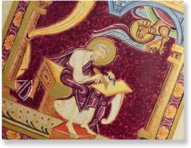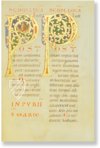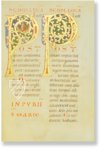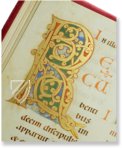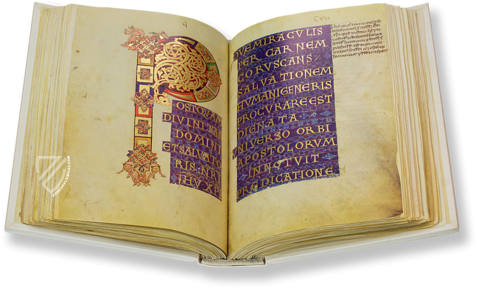Golden Book of Pfäfers
(3,000€ - 7,000€)
A 400-year period of origin makes this codex itself a special kind of contemporary witness: an Evangeliary from the end of the 11th century from the immediate vicinity of Reichenau forms the beginning. Subsequently, a list of abbots from around 1400, as well as property records and legal texts, offer a detailed insight into the medieval monastic life of the Swiss Benedictine Abbey of Pfäfers. The third part contains German translations of later additions to the Evangeliary and was probably made around 1450. The Ottonian and Gothic illuminations are held together by a magnificent Renaissance binding with gilt silver fittings. They and the 4 full-page miniatures, splendidly but at the same time discreetly decorated with gold, and partly half-page gold initials gave the codex its name. Its contemplation thus becomes a journey through time.
Golden Book of Pfäfers
Since 1838, the Abbey Archives in St. Gall have preserved the Golden Book of Pfäfers, an extremely remarkable document of medieval art and cultural history in several respects. The importance and economic strength of Pfäfers Abbey, which since its founding from Reichenau Abbey ca. 740 had grown into a spiritual center of enormous charisma, become clear in the exquisite decoration of the Evangeliary. In its present form, the manuscript combines three different parts:
Part 1 (fol. Iv-28v) contains an Evangeliary with later entries concerning rents (from the early 14th century). The book decoration includes four full-page Evangelist portraits and numerous gold initials. Date of origin: last quarter of the 11th century. Attributable to the close circle of Reichenau book illumination.
Part 2 (fol. 29r-40v) contains a list of the abbots of Pfäfers, property records, and legal texts. Colored pen and ink drawings throughout. Date of origin: ca. 1400, Pfäfers.
Part 3 (fol. 41r-52v) contains the German translation of the Latin religious and legal texts that were added in the Evangelist section. Date of origin: ca. 1450, Pfäfers.
A Magnificent Jewel in Gold and Purple
Four full-page Evangelist portraits, framed like panel paintings and underlaid with precious marbled purple backgrounds, mark the beginning of each of the Gospels. Formally and stylistically, these miniatures, with their architectural backdrops, stylized vegetal ornamentation of the elaborate framing, and the head type and physiognomy of the figures, are still entirely in the tradition of the famous Reichenau Abbey school. In addition, the carefully executed initials of the 31 selected Gospel texts used as liturgical readings serve both a structuring and decorative function. Colored backgrounds and contours increase the luminosity of the golden, vegetal overgrown letter shafts.
Unique in More Ways Than One
The two-column layout of the text is a rarity in type history. It is not found in any other known Ottonian-Salian gospel altarpiece. The dominant formal design element of the second section is the double arcades, in whose arched openings the text is inscribed. Above them appear the historical figures of high ecclesiastical dignitaries. These colored pen drawings clearly show characteristics of the International Soft Style, which makes the Liber Aureus one of the very rare testimonies of this style in book art. The art historian will appreciate the presence of two different stylistic periods – the Ottonian-Salian and the International Soft Style – in the Liber Aureus, the liturgical scholar will emphasize the Gospel texts of St. John, St. Luke, St. Mark and St. Matthew in a rare sequence, historians and legal historians will appreciate the informative entries on the organization and administration as well as the ownership and legal relations of Pfäfers Abbey.
Treasure from Pfäfers Abbey
The significance of the Golden Book, however, goes far beyond such individual considerations. In the connection of the various texts concerning their spiritual and material livelihood, the codex spans, as it were, the existence of the monks of Pfäfers. Together with the Liber Viventium, the Liber Aureus forms a corpus that is one of the most important memorial books of the Middle Ages. The so-called Golden Book owes its name on the one hand to the very elaborate gold decoration of the miniatures and initials, and on the other hand to the gilded silver fittings of its magnificent Renaissance binding: created ca. 1590, the finely chiseled reliefs on red velvet attest to the great religious and political importance that Pfäfers Abbey still possessed at that time.
Codicology
- Alternative Titles
- Das Goldene Buch von Pfäfers
- Size / Format
- 106 pages / 28.1 × 18.8 cm
- Origin
- Switzerland
- Date
- Ca. 1070–1450
- Script
- Carolingian minuscule Uncial Capitals
- Illustrations
- 4 full-page miniatures of the Evangelists, 31 gold leaf initials, and pen-and-ink drawings
- Content
- Lavishly decorated Gospel texts, a full list of Abbots at Pfäfers, and other documents provide a vivid picture of monastic existence at Pfäfers
- Artist / School
- Reichenau school
Golden Book of Pfäfers
Portrait of Luke the Evangelist
This fine Evangelist portrait has all the hallmarks of Ottonian illumination: classical forms, a rich purple background, and gleaming gold leaf. As his Evangelist Symbol – the winged bull or ox – looks down approvingly and holding the Gospel about to be written, Saint Luke works diligently and uses both hands: his right hand holds a gold stylus and his left holds a knife with which to sharpen it, which he apparently needs to use often because of how hard he is working.

Golden Book of Pfäfers
Incipit Page: Gospel of Luke
Appearing opposite the Evangelist portrait, the opening words of the Gospel of Luke are adorned here by two large “P” initials, which are rendered in glimmering gold leaf elegantly filled in with primary colors. These initials have tendril curls with red shadows that intertwine in a manner that is reminiscent of Insular illumination.
This page is a fine example of art from the Reichenau school, exhibiting both creativity in its design as well as precision in its execution. Arranged in two columns, the text is a testament to the masterful scribe who put it to parchment and is uniformly written with clean, straight margins. Expensive red ink was used in the headers, to begin new sentences, and to complete the words begun by the golden initials.

#1 Das Goldene Buch von Pfäfers (De Luxe Edition)
Language: German
(3,000€ - 7,000€)
#2 Das Goldene Buch von Pfäfers (Standard Edition)
Language: German
(under 1,000€)
- Treatises / Secular Books
- Apocalypses / Beatus
- Astronomy / Astrology
- Bestiaries
- Bibles / Gospels
- Chronicles / History / Law
- Geography / Maps
- Saints' Lives
- Islam / Oriental
- Judaism / Hebrew
- Single Leaf Collections
- Leonardo da Vinci
- Literature / Poetry
- Liturgical Manuscripts
- Medicine / Botany / Alchemy
- Music
- Mythology / Prophecies
- Psalters
- Other Religious Books
- Games / Hunting
- Private Devotion Books
- Other Genres
- Afghanistan
- Armenia
- Austria
- Belgium
- Belize
- Bosnia and Herzegovina
- China
- Colombia
- Costa Rica
- Croatia
- Cyprus
- Czech Republic
- Denmark
- Egypt
- El Salvador
- Ethiopia
- France
- Germany
- Greece
- Guatemala
- Honduras
- Hungary
- India
- Iran
- Iraq
- Israel
- Italy
- Japan
- Jordan
- Kazakhstan
- Kyrgyzstan
- Lebanon
- Liechtenstein
- Luxembourg
- Mexico
- Morocco
- Netherlands
- Palestine
- Panama
- Peru
- Poland
- Portugal
- Romania
- Russia
- Serbia
- Spain
- Sri Lanka
- Sweden
- Switzerland
- Syria
- Tajikistan
- Turkey
- Turkmenistan
- Ukraine
- United Kingdom
- United States
- Uzbekistan
- Vatican City
- A. Oosthoek, van Holkema & Warendorf
- Aboca Museum
- Ajuntament de Valencia
- Akademie Verlag
- Akademische Druck- u. Verlagsanstalt (ADEVA)
- Aldo Ausilio Editore - Bottega d’Erasmo
- Alecto Historical Editions
- Alkuin Verlag
- Almqvist & Wiksell
- Amilcare Pizzi
- Andreas & Andreas Verlagsbuchhandlung
- Archa 90
- Archiv Verlag
- Archivi Edizioni
- Arnold Verlag
- ARS
- Ars Magna
- ArtCodex
- AyN Ediciones
- Azimuth Editions
- Badenia Verlag
- Bärenreiter-Verlag
- Belser Verlag
- Belser Verlag / WK Wertkontor
- Benziger Verlag
- Bernardinum Wydawnictwo
- BiblioGemma
- Biblioteca Apostolica Vaticana (Vaticanstadt, Vaticanstadt)
- Bibliotheca Palatina Faksimile Verlag
- Bibliotheca Rara
- Boydell & Brewer
- Bramante Edizioni
- Bredius Genootschap
- Brepols Publishers
- British Library
- C. Weckesser
- Caixa Catalunya
- Canesi
- CAPSA, Ars Scriptoria
- Caratzas Brothers, Publishers
- Carus Verlag
- Casamassima Libri
- Centrum Cartographie Verlag GmbH
- Chavane Verlag
- Christian Brandstätter Verlag
- Circulo Cientifico
- Club Bibliófilo Versol
- Club du Livre
- CM Editores
- Collegium Graphicum
- Collezione Apocrifa Da Vinci
- Comissão Nacional para as Comemorações dos Descobrimentos Portugueses
- Coron Verlag
- Corvina
- CTHS
- D. S. Brewer
- Damon
- De Agostini/UTET
- De Nederlandsche Boekhandel
- De Schutter
- Deuschle & Stemmle
- Deutscher Verlag für Kunstwissenschaft
- DIAMM
- Droz
- E. Schreiber Graphische Kunstanstalten
- Ediciones Boreal
- Ediciones Grial
- Ediclube
- Edições Inapa
- Edilan
- Editalia
- Edition Deuschle
- Edition Georg Popp
- Edition Leipzig
- Edition Libri Illustri
- Editiones Reales Sitios S. L.
- Éditions de l'Oiseau Lyre
- Editions Medicina Rara
- Editorial Casariego
- Editorial Mintzoa
- Editrice Antenore
- Editrice Velar
- Edizioni Edison
- Egeria, S.L.
- Eikon Editores
- Electa
- Emery Walker Limited
- Enciclopèdia Catalana
- Eos-Verlag
- Ephesus Publishing
- Ernst Battenberg
- Eugrammia Press
- Extraordinary Editions
- Fackelverlag
- Facsimila Art & Edition
- Facsimile Editions Ltd.
- Facsimilia Art & Edition Ebert KG
- Faksimile Verlag
- Feuermann Verlag
- Folger Shakespeare Library
- Franco Cosimo Panini Editore
- Friedrich Wittig Verlag
- Fundación Hullera Vasco-Leonesa
- G. Braziller
- Gabriele Mazzotta Editore
- Gebr. Mann Verlag
- Gesellschaft für graphische Industrie
- Getty Research Institute
- Giovanni Domenico de Rossi
- Giunti Editore
- Graffiti
- Grafica European Center of Fine Arts
- Guido Pressler
- Guillermo Blazquez
- Gustav Kiepenheuer
- H. N. Abrams
- Harrassowitz
- Harvard University Press
- Helikon
- Hendrickson Publishers
- Henning Oppermann
- Herder Verlag
- Hes & De Graaf Publishers
- Hoepli
- Holbein-Verlag
- Houghton Library
- Hugo Schmidt Verlag
- Idion Verlag
- Il Bulino, edizioni d'arte
- ILte
- Imago
- Insel Verlag
- Insel-Verlag Anton Kippenberger
- Instituto de Estudios Altoaragoneses
- Instituto Nacional de Antropología e Historia
- Introligatornia Budnik Jerzy
- Istituto dell'Enciclopedia Italiana - Treccani
- Istituto Ellenico di Studi Bizantini e Postbizantini
- Istituto Geografico De Agostini
- Istituto Poligrafico e Zecca dello Stato
- Italarte Art Establishments
- Jan Thorbecke Verlag
- Johnson Reprint Corporation
- Josef Stocker
- Josef Stocker-Schmid
- Jugoslavija
- Karl W. Hiersemann
- Kasper Straube
- Kaydeda Ediciones
- Kindler Verlag / Coron Verlag
- Kodansha International Ltd.
- Konrad Kölbl Verlag
- Kurt Wolff Verlag
- La Liberia dello Stato
- La Linea Editrice
- La Meta Editore
- Lambert Schneider
- Landeskreditbank Baden-Württemberg
- Leo S. Olschki
- Les Incunables
- Liber Artis
- Library of Congress
- Libreria Musicale Italiana
- Lichtdruck
- Lito Immagine Editore
- Lumen Artis
- Lund Humphries
- M. Moleiro Editor
- Maison des Sciences de l'homme et de la société de Poitiers
- Manuscriptum
- Martinus Nijhoff
- Maruzen-Yushodo Co. Ltd.
- MASA
- Massada Publishers
- McGraw-Hill
- Metropolitan Museum of Art
- Militos
- Millennium Liber
- Müller & Schindler
- Nahar - Stavit
- Nahar and Steimatzky
- National Library of Wales
- Neri Pozza
- Nova Charta
- Oceanum Verlag
- Odeon
- Orbis Mediaevalis
- Orbis Pictus
- Österreichische Staatsdruckerei
- Oxford University Press
- Pageant Books
- Parzellers Buchverlag
- Patrimonio Ediciones
- Pattloch Verlag
- PIAF
- Pieper Verlag
- Plon-Nourrit et cie
- Poligrafiche Bolis
- Presses Universitaires de Strasbourg
- Prestel Verlag
- Princeton University Press
- Prisma Verlag
- Priuli & Verlucca, editori
- Pro Sport Verlag
- Propyläen Verlag
- Pytheas Books
- Quaternio Verlag Luzern
- Reales Sitios
- Recht-Verlag
- Reichert Verlag
- Reichsdruckerei
- Reprint Verlag
- Riehn & Reusch
- Roberto Vattori Editore
- Rosenkilde and Bagger
- Roxburghe Club
- Salerno Editrice
- Saltellus Press
- Sandoz
- Sarajevo Svjetlost
- Schöck ArtPrint Kft.
- Schulsinger Brothers
- Scolar Press
- Scrinium
- Scripta Maneant
- Scriptorium
- Shazar
- Siloé, arte y bibliofilia
- SISMEL - Edizioni del Galluzzo
- Sociedad Mexicana de Antropología
- Société des Bibliophiles & Iconophiles de Belgique
- Soncin Publishing
- Sorli Ediciones
- Stainer and Bell
- Studer
- Styria Verlag
- Sumptibus Pragopress
- Szegedi Tudomànyegyetem
- Taberna Libraria
- Tarshish Books
- Taschen
- Tempus Libri
- Testimonio Compañía Editorial
- Thames and Hudson
- The Clear Vue Publishing Partnership Limited
- The Facsimile Codex
- The Folio Society
- The Marquess of Normanby
- The Richard III and Yorkist History Trust
- Tip.Le.Co
- TouchArt
- TREC Publishing House
- TRI Publishing Co.
- Trident Editore
- Tuliba Collection
- Typis Regiae Officinae Polygraphicae
- Union Verlag Berlin
- Universidad de Granada
- University of California Press
- University of Chicago Press
- Urs Graf
- Vallecchi
- Van Wijnen
- VCH, Acta Humaniora
- VDI Verlag
- VEB Deutscher Verlag für Musik
- Verlag Anton Pustet / Andreas Verlag
- Verlag Bibliophile Drucke Josef Stocker
- Verlag der Münchner Drucke
- Verlag für Regionalgeschichte
- Verlag Styria
- Vicent Garcia Editores
- W. Turnowski Ltd.
- W. Turnowsky
- Waanders Printers
- Wiener Mechitharisten-Congregation (Wien, Österreich)
- Wissenschaftliche Buchgesellschaft
- Wissenschaftliche Verlagsgesellschaft
- Wydawnictwo Dolnoslaskie
- Xuntanza Editorial
- Zakład Narodowy
- Zollikofer AG










